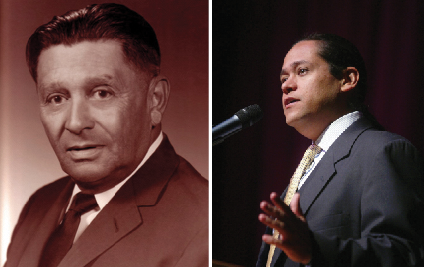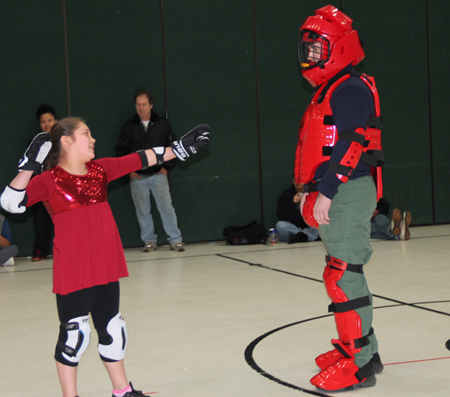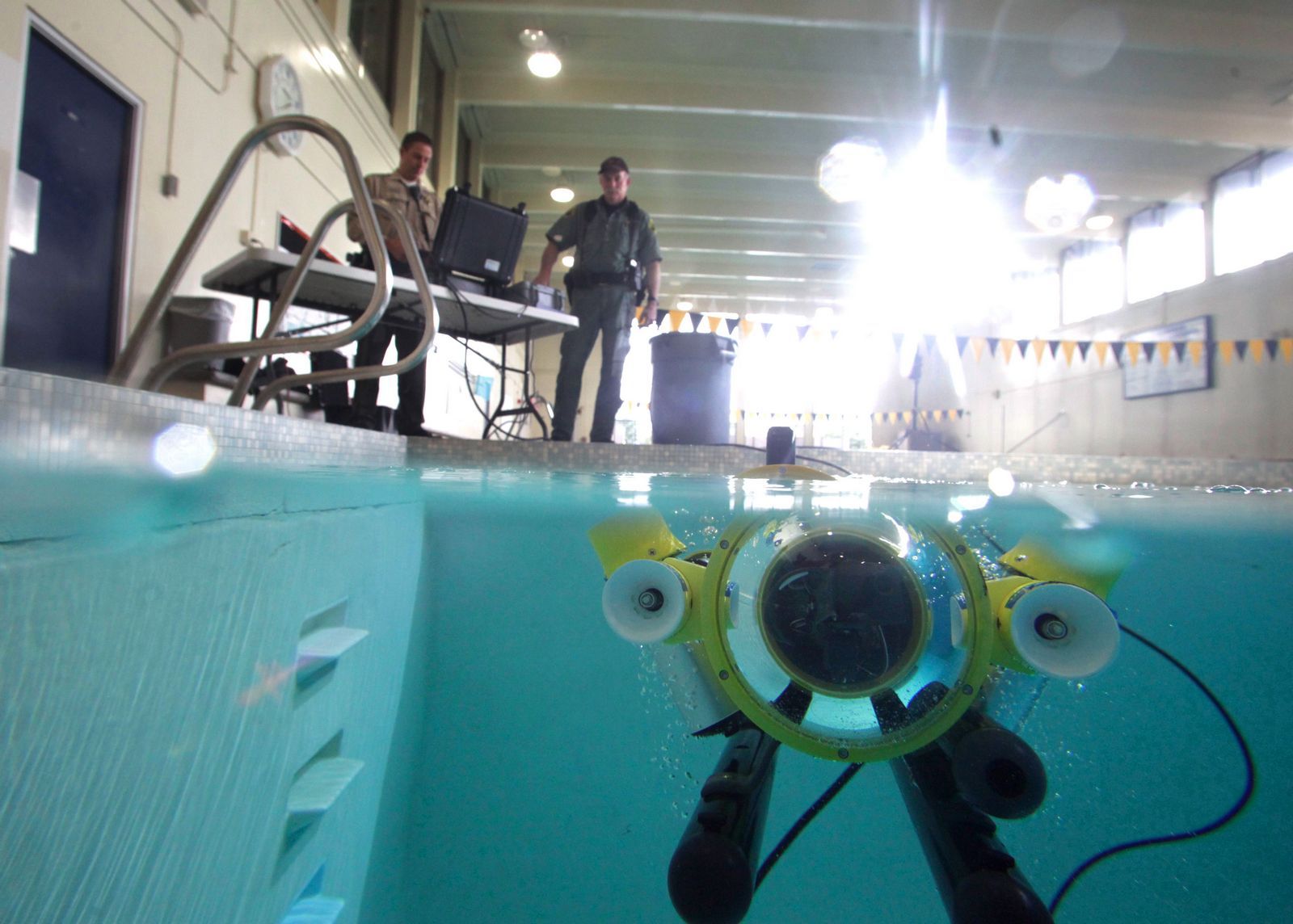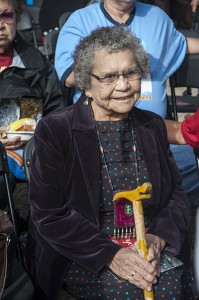The documentary team of Benjamin Drummond and Sara Joy Steele featured the Swinomish Tribe in a video on the Facing Climate Change website.
Facing Climate Change: Coastal Tribes from Benjamin Drummond / Sara Steele on Vimeo.
The Swinomish Tribe has lived on the coasts of the Salish Sea for thousands of years. Today, rising seas not only threaten cultural traditions, but also the economic vitality of this small island nation in the shadow of two oil refineries.
After scientists identified sea level rise as a threat to the Lower Skagit River area, the tribe launched a climate change initiative to study the long-term impacts of climate change on their reservation, and to develop an action plan to adapt. Impacts of sea level rise on the island, including coastal erosion, habitat loss, and declining water quality, raised central concerns. The study presented the Swinomish with a difficult question: whether to plan for inches or feet of rise?
Planning must embrace a range of possibilities. Important factors used to calculate global sea level rise, such as melt rates of the Greenland and Antarctic ice sheets, vary widely. In addition, regional estimates must include local factors such as wind patterns and tectonic activity.
Month: March 2013
Lower Elwha Klallam Tribe Elder Adeline Smith Passes Away
Lower Elwha Klallam Tribe elder Adeline Smith died March 19, 2013. She was 95. She was known for helping preserve the Tse-whit-zen village site and the Klallam Language, and played a part in the removal of the Elwha River dams.
From the Peninsula Daily News:
PORT ANGELES — Adeline Smith, the Lower Elwha Klallam tribal elder who played key roles in preserving the site of Tse-whit-zen village, the Elwha River dam removals and documenting the Klallam language, has died.
Smith, who turned 95 last Friday, died Tuesday morning in Tacoma, where she was staying with family members, Lower Elwha Klallam Tribal Chairwoman Frances Charles said Tuesday afternoon.
Lower Elwha Klallam Tribe elder Adeline Smith, at the September 2011 Elwha River Dam Removal ceremony. She passed away March 13, 2013.
Smith celebrated her 95th birthday with family members and other members of the tribe, Charles said.
No memorial service date has been announced.
Born March 15, 1918, Smith grew up in the Port Angeles area, watching the decline in salmon runs on the Elwha River and the disappearance of Tse-whit-zen village on the Port Angeles Harbor waterfront.
In the early 21st century, she witnessed the preservation of the Tse-whit-sen site after a state dry-dock construction project to build floating-bridge pontoons was halted.
And she celebrated with tribal members at the September 2011 ceremonies to begin the removal of the two Elwha River dams.
Once the reservoir behind the lower Elwha Dam was drained, she witnessed the tribe’s ceremonial creation site that had been inundated since Lake Aldwell was created just before she was born.
Upper Skagit Tribe testing tangle nets to study steelhead population
Source: Northwest Indian Fisheries Commission
The Upper Skagit Tribe is exploring the possibility of using a tangle net to learn more about Skagit River steelhead.
Last year, the tribe collected scales to determine the age and life history of 75 steelhead harvested over a two-week period during its ceremonial and subsistence fishery. But from a scientific standpoint, researchers need more than 75 samples and a longer sample period to learn about the steelhead run. This year, tribal natural resources staff are investigating whether a tangle net could enable them to sample a greater number of fish without increasing the impact to the run.
Tangle nets are similar to gillnets, but have a smaller mesh size, allowing fish to be released.
“Tangle nets have been demonstrated to allow steelhead to be released with limited mortality,” said Bob McClure, fisheries biologist for the Upper Skagit Tribe.
“The purpose of this year’s exploratory fishery is to collect additional biological and abundance data for management purposes,” McClure said. “If the tangle net fishery is successful, we could eventually use this method to gather data about winter steelhead outside of the traditional commercial fishery.”
During future fisheries, fishermen who harvest steelhead tagged with fluorescent orange Visual Implant tags are asked to contact McClure at 360-854-7058 with the tag and catch information.
In addition to taking scale samples, tribal natural resources staff measure and mark each steelhead with a small reflective orange tag behind its right eye. The tag will provide additional information if the fish is recaptured or harvested later during this fishery. It also allows for long-term identification beyond the duration of the test fishery.
For more information, contact: Bob McClure, fisheries biologist, Upper Skagit Tribe, 360-854-7058 or
Early Pioneers of Indian Gaming Had Same Goal: To Help Their People
Gale Courey Toensing, Indian Country Today Media Network, March 27, 2013

This year marks the 25th anniversary of the passage of the Indian Gaming Regulatory Act, the legislation that dramatically changed the economic landscape for tribal nations with casinos. In recognition of that momentous event, Indian Country Today Media Network decided to take a look at some of the early heroes of Indian gaming—the tribes and individuals who advanced it both before and after the passage of the Indian Gaming Regulatory Act.
TABLE STAKES
The precursor to IGRA was the 1987 U.S. Supreme Court ruling in California v. Cabazon Band of Indians, which upheld the right of sovereign Indian nations to conduct gaming on Indian lands free of state control when similar gaming is permitted by the state elsewhere. While Cabazon is often cited as the legal foundation for Indian gaming, a Supreme Court ruling more than a decade earlier paved the way for Cabazon: Bryan v. Itasca County. Russell and Helen Bryan, the Chippewa couple who brought the case forward, deserve a top spot on the list of early Indian gaming heroes, even though they had nothing to do with gaming.
In June 1972, the Bryans received a personal property tax bill for $29.85 from Itasca County in Minnesota, an assessment on their trailer home on the Leech Lake Indian Reservation. They took it to the local Legal Aid Society office, and attorneys there brought a lawsuit to challenge the tax bill in state court. The assessment, which kept going up over time, was challenged all the way up to the U.S. Supreme Court, and in June 1976, the high court ruled that states do not have authority to tax Indians on Indian reservations or to regulate Indian activities on reservations.
“Bryan thus was the bedrock upon which the Indian gaming industry began,” Kevin K. Washburn wrote in a Minnesota Law Review article entitled: “The Legacy of Bryan v. Itasca County: How an Erroneous copy47 Tax Notice Helped Bring Tribes $200 Billion in Indian Gaming Revenue”. Washburn, who was Oneida Nation Visiting Associate Professor of Law at Harvard Law School when his article was published in 2007, is currently the Interior Department’s Assistant Secretary—Indian Affairs. “If economic impact is a useful measure of importance, Bryan may be the most important victory for American Indian tribes in the U.S. Supreme Court in the latter half of the 20th century. Indian gaming is simply the most successful economic venture ever to occur consistently across a wide range of American Indian reservations,” Washburn wrote. If there’s any doubt about the importance of Bryan, he added, “consider that on the basis of the Bryan precedent, the Indian gaming industry was generating between copy00 million and $500 million in annual revenue before Cabazon was decided.”
And, indeed, all across the U.S., Indian country was bustling with gaming activities during the 1970s and 1980s.
THE BIRTH OF RED CAPITALISM
One of Turtle Island’s greatest advocates for Indian sovereignty and self-determination was the late, iconic Mescalero Apache leader Wendell A. Chino. Born in 1923, Chino was elected chairman of the Mescalero Apache’s tribal governing committee at the age of 28 and was reelected every two years until 1965 when he was named the first president of the Mescalero Apache Tribe, serving in that capacity for 16 consecutive terms.
Chino spearheaded the tribe’s shift to controlling its own natural resources, and by the same philosophy of “red capitalism,” in 1975 the Mescalero Apache Nation built the Ski Apache Ski Resort and the Inn of the Mountain Gods resort in the Sierra Blanca Peak, including the first tribal-owned golf course in the United States. At the Mescalero resort property, Chino was also instrumental in establishing one of the earliest Indian casinos (now called the Inn of the Mountain Gods Resort and Casino) by asserting that the state of New Mexico could not outlaw gaming on sovereign tribal land.
Chino led his Nation until his death in 1998 at the age of 74. “In the scheme of the 20th century, it has been said that Wendell Chino was a Martin Luther King or a Malcolm X of Indian country. He was truly a modern warrior,” said Roy Bernal, then chairman of the All Indian Pueblo Council and a member of the Taos Pueblo, in Chino’s obituary in the The New York Times.
![From left: Hayward, Tommie and Halbritter (Courtesy Seminole Tribune/Seminole Tribe of Florida [Tommie]; courtesy Mashantucket Pequot Tribal Nation [Hayward]; Onieda Indian Nation [Halbritter])](https://ictmncdn1.tgpstage1.com/sites/default/files/default/files/uploads/screen_shot_2013-03-26_at_4.03.54_pm.png)
Fifteen years ago, the National Indian Gaming Association (NIGA) established the Wendell Chino Humanitarian Award in his name to recognize tribal leaders whose actions have improved the lives of citizens in Indian country. For the first time, in 20 the award was presented to an entire tribe, the Quapaw Tribe of Oklahoma, whose altruistic and humanitarian actions helped tornado victims and their devastated community of Joplin, Missouri.
The winner of this year’s award will be honored on March 26 at the Wendell Chino Humanitarian Award Banquet during NIGA’s Indian Gaming 2013 Tradeshow and Convention in Phoenix.
On the East Coast, the Oneida Indian Nation, the Seminole Indians of Florida and the Mashantucket Pequot Tribal Nation were among the earliest to develop Indian gaming.
FROM THE ASHES
Oneida’s gaming enterprise emerged from a tragedy. In June 1976, the aunt and uncle of Ray Halbritter, Oneida Nation Representative and Chief Executive Officer of Nation Enterprises, parent company of Indian Country Today Media Network, burned to death after their trailer caught fire. “The city of Oneida, which is named after us, refused to send the fire department,” Halbritter says. “It was a very tragic time for us. It was horrible.”
Tensions both on and off the reservation were running high because the nation had filed a lawsuit to restore its land rights, which was opposed by many in the surrounding communities. The reservation by that time had been reduced to 32 acres divided into 36 trailer lots, with a mud road down the center and no services. After that tragic fire, the nation’s leaders knew they needed to provide fire protection for the people, but there was no money, Halbritter recalls. They decided to follow the lead of the small fire departments and charities in the surrounding communities that held bingo and “Las Vegas” gambling nights as fund-raisers.
By October of that year, the Oneidas’ bingo operation was up and running. In an effort to develop a better relationship with the city of Oneida, the nation planned a bingo night fund-raiser for the city police department’s benevolent society. The nation informed the state of its plans and invited members of the police department to the event. “A certain number of police came representing the department, but we didn’t anticipate they would use the opportunity to arrest us for operating bingo without a license,” Halbritter recalls.
The nation didn’t have money to wage a legal battle against the state, so their high-stakes bingo operation was shut down. The Oneidas then opened a high-stakes bingo operation in 1985 after the Seminoles in Florida had fought—and won—some of the most important legal battles for Indian gaming. “After they went through all the legal battles, I went down there to visit and they had a flier that told the story of Seminole bingo and they mentioned the Oneida Nation of New York; they talked about the bingo that we had stared years earlier,” Halbritter says.
By 1993, the Oneida Nation, under Halbritter’s leadership, transformed its high-stakes bingo operation into the hugely successful Turning Stone Resort Casino, a world-class golf, gaming, entertainment and hotel resort destination.
SOVEREIGNTY IN THE SUNSHINE STATE
The Seminoles, under the leadership of Howard Tommie, had opened a high-stakes bingo hall on their reservation on December 14, 1979. It was the first casino on Indian land in the country and Broward County Sheriff Robert Butterworth threatened to shut it down and arrest the Seminoles for allegedly violating a Florida gaming statute the minute it opened. The tribe sued the county in Seminole v. Butterworth and won in both federal district court and in the appeals court, which upheld the lower court ruling that Indian tribes have sovereignty rights that are protected by the federal government from interference by state government. The ruling affirmed the Seminoles’ sovereign right to conduct high-stakes bingo on its land and established the tribe’s leadership in Class II gaming.
THE CONNECTICUT MIRACLE
Meanwhile, in Connecticut Pequot leader Skip Hayward was engaged in a three-pronged battle: (1) to save the Pequot reservation from a state takeover after his grandmother Elizabeth George died in 1973, leaving the 200-acre reservation without any residents; (2) to re-establish the fragmented Pequot people as a tribal community and (3) to gain federal acknowledgment. Working with attorneys in a Legal Aid office in 1974 and following a model set by the Penobscot and Passamaquoddy tribes in Maine, Hayward initiated a land claim lawsuit based on the 1790 Indian Nonintercourse Act and drafted a settlement agreement. The land claim raised a storm of opposition in the community and throughout the state, and was challenged in federal court. In 1983, the Mashantucket Pequot Tribal Nation received from Congress 2,000 acres of land, federal acknowledgement, and $300,000 to invest in tribal economic development. Thus began the path that led to the creation of Foxwoods Resort Casino, the largest gaming facility in the country, and to an authentic and astonishing rags-to-riches story for the Pequot people.
“Clearly, we would not be here today without the remarkable dedication and commitment of our early leadership and that goes back to Skip Hayward,” Mashantucket Pequot Chairman Rodney A. Butler says. “His willingness to stand up and fight for Indian rights in the 1970s and again in the 1980s
![Clockwise, top left: Wendell Chino, Jana McKeag, Leonard Prescott, Marge Anderson (Richard Pipes/Albuquerque Journal [Chino]; courtesy Leonard Prescott](https://ictmncdn1.tgpstage1.com/sites/default/files/default/files/uploads/screen_shot_2013-03-26_at_4.04.07_pm.png)
on Indian gaming can’t be underscored enough. Clearly we wouldn’t be here without his persistence and efforts.”
Hayward started a very successful high-stakes bingo operation in 1986. After the Cabazon ruling in 1987 and the passage of IGRA in 1988, the nation began its pursuit of a casino. By 1993, the bingo operation had evolved into the full-fledged Foxwoods Resort Casino. Hayward had envisioned Foxwoods as the first world-class, family-oriented destination resort casino. “That was a tremendous credit to him and where he wanted it to grow,” Butler says.
Foxwoods’s spectacular success has stood as an inspirational story for all of Indian country, he adds. “Here’s this small tribe from Connecticut now owning one of the largest casinos in the world—we can all do that, right? Well, we can’t all do that, but just the inspiration and hope that it provided, I think, was a big influence on Indian gaming.”
MYSTIC LAKE
The Shakopee Mdwakanton Sioux (Dakota) Community in Minnesota was treading a similar path to Indian gaming success in the early 1980s. The poverty-stricken tribe opened a high-stakes bingo hall in 1982, which laid the groundwork for the development of Mystic Lake Casino a decade later. Leonard Prescott, a founding member of the National Indian Gaming Association in 1985, became the Shakopee chairman in 1987. “I built Mystic Lake Casino in 1991, 1992,” Prescott says. Under his leadership the Shakopee and other Minnesota tribes negotiated the first tribal state gaming compacts in the country in 1989. “The compacts are perpetual,” he says. “We have no time limits. We have no jackpot limits. We pay copy0,000 per tribal government which means today we pay copy50,000 to the state of Minnesota for a $2.5 billion business.”
The Mystic Lake Casino Hotel is one of the most successful in the country, providing the less than 400 citizens of the nation with more than copy million annually in payments. The nation also has a philanthropic program that has distributed hundreds of millions of dollars to local governments, organizations and people in Indian country. Last year, Shakopee donated $29 million.
Prescott says he is astounded at the tribe’s transformation. “When we first developed our bingo hall, we had a dirt road, we were making tracks to our building that sold welfare products, we had no sewer and water. So coming from there to where we are today is miraculous.”
WEST COAST FAST-TRACK
California developed the largest number of Indian gaming facilities in the shortest amount of time in the 1980s and 1990s, and even now—with 62 gaming tribes—it has the highest number of gaming tribes in the country, according to Casino City’s Indian Gaming Industry Report for 2013. The Pechanga Band of Luiseño Indians opened its casino in 1995, the last tribe to do in the state during that early era, said Pechanga Chairman Mark Macarro. Numerous California tribes had successful bingo operations in the 1980s—the San Manuel, Morongo, Cabazon, Barona, and Viejas, Sycuan and Yocha Dehe. “These were the first and therefore the trailblazers,” Macarro says.
Several California tribal gaming facilities were shut down in the 1980s by sheriffs eager to prove tribal gaming was illegal under state laws. Those raids led directly to the watershed ruling in Cabazon, “which then rather quickly was contained and abridged in October of 1988 by the Indian Gaming Regulatory Act,” Macarro says.
But state opposition didn’t stop even after Cabazon and IGRA. Then-governor Pete Wilson disliked gaming and refused to negotiate with the tribes, despite IGRA’s mandate that he do so. Wilson complained about tribal gaming to anyone who’d listen—federal and state officials, Congress, U.S, attorneys, law enforcement, Macarro recalls. Finally, in March 1997, U.S. Attorney Nora M. Manella took action. “Each tribal chair (myself included) was issued a summons to appear in Los Angeles Federal District Court. Our machines had been legally seized, i.e. they were arrested—it’s called in rem seizure.”
The tribal leaders didn’t go to jail, and they called for a huge demonstration. Around 5,000 to 7,000 employees and supporters rallied and shut down the streets of downtown Los Angeles, Macarro says. “The point was: Shut us down? Do so and lose a huge economic engine and these thousands of people go unemployed. The high-point of this rally was when all the tribal chairs stood literally in unity on the top step of the courthouse—summons in hand—and spoke to the crowd. It galvanized us as a group and forged a strong bond which became the keystone for the first statewide ballot proposition battle—Prop 5—in 1988. This was the next major evolution for tribal cohesion and became a watershed period.” Macarro says. Prop 5 passed with 62 percent of the vote and established tribal-state compacts that allowed, among other things, slot machines in tribal casinos.
DOUBLING DOWN
This has been only a partial look at the early Indian gaming “heroes”—it would be impossible to acknowledge the contributions of everyone who worked to make Indian gaming a reality. But no list of Indian gaming trailblazers would be complete without mention of two great women of gaming: Marge Anderson, of the Mille Lacs Band of Ojibwe in Minnesota, was the driving force behind the opening of Grand Casino Mille Lacs and Grand Casino Hinckley within four years of the passage of the Indian Gaming Regulatory Act in 1988; Jana McKeag, of the Cherokee Nation of Oklahoma, was one of the commissioners on the newly created National Indian Gaming Commission in 1991 and began the commission’s first task—writing the regulations that govern Indian gaming.
In the years since the passage of IGRA, Indian gaming has grown to a $27 billion-plus a year industry, giving tribal governments the means to build their nations and provide services for their citizens. It has also infused the U.S. economy with hundreds of billions of dollars and almost 700,000 jobs. While there are potential threats to Indian gaming in the long-term, the industry is likely to continue its success into the mid-term future, says economist Alan Meister, author of Casino City’s Indian Gaming Industry Report for 2013. “The economy will continue to improve over time, bringing back disposable income, consumer confidence and spending on casino gambling.” So, in the words of former Shakopee chairman Leonard Prescott, it is likely the country will be able to enjoy the miraculous phenomenon of Indian gaming for the foreseeable future.
Tulalip elementary students graduate from self-defense class
By Kim Kalliber and Jeannie Briones; photos by Jeannie Briones

Empowerment, self-esteem and safety skills – these are a few of the core values of the radKIDS program and 21 proud radKIDS graduates are now armed with these important life skills. Tulalip police officers, instructors and

students celebrated the graduation at Quil Ceda & Tulalip Elementary School on March 26.
RadKIDS, which has been in operation at Quil Ceda & Tulalip Elementary for two years, is a non-profit educational organization dedicated to providing effective lifesaving skills to children. Through this program, kids become empowered to recognize and avoid dangerous situations, and to replace the fear and confusion they may feel in these situations with confidence and self-defense skills.
“There is no other program like it for safety. Students benefit from learning about safety, like being safe from a bully, staying away from drugs and alcohol and keeping safe from someone who’s trying to harm them,” said Rochelle Lubbers, Tulalip Police Department Emergency Services Manager and radKIDS Instructor.
During the graduation, students received a certificate and got to demonstrate their newly acquired self-defense skills against the “redman.” Tulalip police officer Mark Nelson wore the padded red suit to protect himself from the kids slick moves like shin kicks, toe kicks and knee kicks.
This training includes kids and their parents creating a password. A password is a word that is used as a safety check should a parent need to send another adult to pick up a child from school, sports, etc. The purpose of the password is to protect your child from going with someone under false pretenses. When approached by a stranger, the child will ask for a password, if the stranger does not know the password, the child is then taught to run away or seek help.
“We can get away from who tries to take us. It feels good to be safe,” said Nakoyia Fryberg, radKIDS graduate and Tulalip tribal member.
To learn more about the radKIDS program visit www.radkids.org
Catch Washington Stealth in action Saturday night, March 30
It’s not gender of parents, but quality of care, researchers say
Research into the effects of same-sex parenting shows that the sexual orientation of parents is not a major determinant in how well children fare. What matters more, researchers found, is the quality of parenting and the family’s economic well-being.
By Sandhya Somashekhar, The Washington Post

WASHINGTON — Amid the legal arguments at Tuesday’s Supreme Court hearing on same-sex marriage, there loomed a social-science question: How well do children turn out when they are raised by gay parents?
Justice Anthony Kennedy, who is widely considered the swing vote, called the topic “uncharted waters.” Conservative Justice Samuel Alito Jr. wryly asked, “You want us to step in and render a decision based on an assessment of the effects of this institution which is newer than cellphones or the Internet?”
Indeed, gay marriage is a relatively new phenomenon in the United States. It has only been legal since 2004, when Massachusetts began issuing marriage licenses to same-sex couples. Eight more states and Washington have legalized same-sex nuptials since then, but they have been banned in 35 states.
Researchers have been delving into the effects of same-sex parenting only since the 1980s and 1990s. Most of the studies involve relatively small samples because of the rarity of such families.
Still, there is a growing consensus among experts that the sexual orientation of parents is not a major determinant in how well children fare in school, on cognitive tests and in terms of their emotional development.
What matters more, researchers found, is the quality of parenting and the family’s economic well-being.
“I can tell you we’re never going to get the perfect science, but what you have right now is good-enough science,” said Benjamin Siegel, a professor of pediatrics at Boston University School of Medicine. “The data we have right now are good enough to know what’s good for kids.”
Siegel co-authored a report issued by the American Academy of Pediatrics last week when it came out in favor of legalizing same-sex marriage. The group looked at dozens of studies conducted over 30 years and concluded that legalizing same-sex marriage would strengthen families and benefit children.
The best study, Siegel said, is the National Longitudinal Lesbian Family Study, which began in 1986 with 154 lesbian mothers who conceived children through artificial insemination. A recent look at 78 offspring found that the children did fine — better, even, than children in a similar study involving more diverse families.
Many opponents of same-sex marriage argue that the academy’s conclusions are premature. They point to some recent studies, including one from Mark Regnerus, a sociology professor from the University of Texas at Austin.
Regnerus, who could not be reached for this article, found that adults who reported being raised by a person who had a homosexual experience were more likely to be on welfare or experience sexual abuse.
Regnerus has been the subject of intense criticism from mainstream researchers and pro-gay marriage activists. But opponents of same-sex marriage say his work should provide a note of caution on an issue that has yet to be studied in adequate depth.
“What the social science makes clear, and it has for several decades, is that children tend to do best when they’re raised by their married biological parents,” said Jennifer Marshall, director of domestic policy studies for the conservative Heritage Institute. “In the case of same-sex households, there is not yet evidence that (children) are going to be the same. There’s every reason to believe that different family structures will have different outcomes.”
Susan Brown, a professor of sociology at Bowling Green State University in Ohio who studies family structures, said it is true that decades of research show that children turn out slightly better when they are raised by their biological parents compared with those reared by single parents or in “step” households.
But children raised in committed same-sex couple-led households do not appear to do statistically worse, she said.
“One thing we’re finding that’s very important for children is stability in their family life,” Brown said.
“To the extent that marriage is a vehicle through which children can achieve stability,” she said, “It only follows that marriage is something that would be beneficial to children.”
Eagles on the mend after scavenging euthanized horses
Seven eagles poisoned nearly to death after feeding on carcasses of euthanized horses in Lewis County should be well enough for release from wildlife shelters this week.
By Lynda V. Mapes, The Seattle Times

Seven eagles poisoned nearly to death after feeding on euthanized horse carcasses are expected to be released this week.
The eagles are alert, getting feisty and are being moved to outdoor cages, said Mike Pratt, wildlife director at the West Sound Wildlife Shelter on Bainbridge Island, which cared for six of the eagles. The shelter, funded by donations, takes in wild animals of all sorts that have been injured or orphaned.
The shelter started getting calls over the weekend about first one eagle, then a second found nearly dead on private property in Winlock, Lewis County. By the time shelter staffers arrived to pick up the birds on Sunday, four more had become sick, Pratt said. The six birds — five juveniles and an adult — were so ill they were convulsing, vomiting, and could not stand. Two were comatose.
Back at the shelter, volunteers and two veterinarians were waiting. They administered a charcoal purgative around the clock and, by Tuesday morning, even the sickest birds had revived. They may be released by the end of the week, right back where they came from, Pratt said.
A seventh poisoned eagle had been taken to the wildlife shelter at the Audubon Society of Portland on Friday. That eagle, a first-year male, looks excellent and will be released Wednesday, said Lacy Campbell, operations manager at the wildlife center.
Meanwhile, the U.S. Fish and Wildlife Service is investigating the incident, said spokeswoman Joan Jewett. It is a federal offense to poison an eagle, even accidentally.
It all started with horses, euthanized and left by their owner in a field, said Jewett, who added that the carcasses have since been buried.
Stephanie Estrella, director and wildlife rehabilitator of Raindancer Wild Bird Rescue in Olympia, which cared for the birds before the larger Bainbridge shelter could come collect them, said this was the first time she had encountered raptors poisoned by tainted carcasses.
Most of the raptors she has cared for were victims of car strikes, or torn up in fights with other raptors.
She got the first call from Sharon Thomas, a Winlock resident who saw an eagle acting strangely in a field in front of her house.
“It flopped and flew, and flopped and flew. It crashed several times,” Thomas said. “Then it came right to me, it sat right at my feet as if it had come for help.”
Thomas took the eagle to her house, put it in a kennel, took photos of it, and put them on Facebook asking for help. Ultimately, it was Estrella from Raindancer who came to collect the eagle.
Little did Thomas know she was in for a long weekend of more of the same, as she and her neighbors walked and drove the area, on the alert for more animals in distress. “It was heart-wrenching,” Thomas said. “Seeing a large, majestic bird falling over on its head is very sad. Picking them up, seeing them unresponsive and lethargic. Picking up the two others that seemed dead, their eyes were not open, they were barely breathing.”
Eventually, she and the neighbors walking the field and thickets found two horse carcasses, with eagles feeding on them. “I picked an adult off one of the horses. He was covered in rotten meat and blood and so was I,” Thomas said.
She and other neighbors collected six sick eagles, and drove off others trying to feed on the carcasses. “It was very hard to drive away from the work Monday morning,” Thomas said. “I don’t know what other wildlife may have been affected.”
The Longview Daily News reported Monday that the horses’ owner, Debra Dwelly, said she had no idea she had created a hazard until federal wildlife agents, alerted by the animal-shelter operators to the eagles’ plight, showed up at her home on Sunday, after cruising the area in a small plane and spotting the carcasses.
Dwelly told the Daily News the poisoning was an honest mistake that occurred because a friend’s backhoe had broken down, delaying burial of the horses she had put down earlier last week.
Washington state law requires the owners of animals or owners of land on which animal carcasses are found to bury or incinerate carcasses within 72 hours so they do not become a hazard.
Attempts by The Seattle Times to reach Dwelly were unsuccessful Tuesday.
Meanwhile, all seven eagles were getting stronger by the hour. Thomas said she is eager to seeing them released.
“I look forward to them returning and behaving as an eagle should,” Thomas said. “They should be aggressive. You shouldn’t be holding them in your arms.”
Underwater robot will assist with rescue and recovery
By Rikki King, The Herald

EVERETT — In the water, the robot looked like a curious critter.
It glided through the pool, poking its nose up to the surface to nudge at obstacles.
The robot is construction-equipment yellow, about the size of a small dog.
Nearby, specially trained deputies watched its movements on a computer screen, scanning the water through its “eyes.”
The Snohomish County Sheriff’s Office recently acquired an underwater robot, a JW Fishers SeaLion-2, through a federal grant.
They call it “Batman.”
Batman went for a test drive last week at a community pool in south Everett. It splashed around and posed for pictures.
Its true missions are more somber.
The sheriff’s office got Batman in January, Lt. Rodney Rochon said.
Later that month, Batman helped them gather underwater visuals as they pulled a car from the Snohomish River. The bodies of two missing people were inside.
On March 16, Batman found the body of a fisherman who drowned in Silver Lake the day before.
Batman’s worth about $40,000, Rochon said. As part of the federal grant that paid for the acquisition, the dive team and the robot can be called to help with rescue and recovery operations throughout the region.
At least two children and two adults drowned in Snohomish County in 2012.
Rescues are the team’s top priority, Rochon said. In the cases when they can’t rescue someone, they try to find the body.
“We need to recover the victim so the family can get closure,” Rochon said. “It’s not just about the investigation.”
The robot also can be used to gather intelligence and limit the time human divers spend in the water, he said. It can weather harsher conditions and dive deeper — up to 1,000 feet — and for longer than people can. Deputies only can dive 100 feet for safety reasons.
The SeaLion-2 design is most popular with law enforcement, said Chris Combs, a spokesman for JW Fishers, the Massachusetts-based manufacturer. It weighs about 40 pounds. It has high-resolution color cameras in front and back and four motors to propel it forward, backward, up and down. Some models have sonar technology.
“The SeaLion-2 is really a pretty neat little machine,” Combs said.
The sheriff’s office also got to lease a SWAT robot for free for a while last year. On one mission, it helped dissolve a standoff in Marysville.
The lease ended a while back, and that robot went back home.
Prep Roundup
Source: North County Outlook, March 26, 2013
Baseball:
Marysville-Pilchuck: Thanks to last week’s crazy weather, Marysville-Pilchuck baseball started off the year playing three games in as many days. The Tommies lost 5-4 against Meadowdale to kick off the season, but won their next two games thanks to strong pitching performances from Cody Anderson and Jake Luton.
M-P’s first win came Friday over Shoreline, 4-0. Jake Luton struck out nine and walked two through five innings. Kacey Walker was 1-3 with two RBI, and Jake Merrick was 2-2 with an RBI.
The Tommies defeated Lake Stevens 4-1 in a non-league game on Saturday, pushing their record this year to 2-1. Cody Anderson pitched 4 innings of scoreless ball, and Kacey Walker went 2-3 with a walk, a run scored and an RBI.
Marysville Getchell: Marysville Getchell started the season off on the proper foot with a victory over Mariner 5-1, but then dropped two straight. Rylan Fausett pitched a complete game, striking out six and giving up just 6 hits in the Charger’s win. Mariner’s only run came in the top of the seventh inning. Jake Lund was 2-3 for MG with a double and three RBI.
On Wednesday MG gave up 11 hits and committed two errors against Shoreline. The game was called after the fifth inning, and Shoreline won 12-2. MG’s John Clark was 2-3 with a triple.
Getchell lost 14-1 on Friday against the Meadowdale Mavericks. Scoring was not reported for that game.
Arlington: The Eagles are 2-1 on the year after splitting a pair of games this week. Arlington lost on Monday 12-3 at Oak Harbor.
The Eagles were down by just a run heading into the bottom of the sixth, but Oak Harbor put up a pair of big innings, scoring four in the sixth inning and four more in the seventh to put the game out of reach.
On Saturday Ryan Walker picked up his second win of the year and scored the winning run. The Eagles relied on some late inning heroics, tying the game in the fifth, and winning in the bottom of the seventh. Walker was 2-4 with two doubles. Bryce Human drove in the winning run, and Isaiah Vaughn was 2-4.
Lakewood: The Lakewood Boys split a pair of games this week, and their record now sits at 3-1.
The Cougars started the week off with a big 13-2 win over South Whidbey. The five-inning contest saw Lakewood notch nine hits while South Whidbey committed 11 errors in the field. Bradley Keen was credited with the win.
Softball:
Arlington: The Eagles picked up two wins this week to push their record to 3-0. In the three games the Eagles have outscored their opponents 40-1.
On Tuesday Arlington defeated Stanwood in a five inning contest 16-1. Hayley Fields struck out nine, giving up just two hits and one run. Marisa Rathert was 4-4 with three stolen bases, Katelynn McDonald had two doubles, and Lynsey Amundson finished with a double and a triple. The Eagles amassed 21 hits in all.
Hayley Fields was at it again on Friday. She struck out 13, gave no runs, and pushed her record to 3-0 on the year. Fields also went 2-4 with a double. Lynsey Amundson and Marissa Rathert each hit a triple.
Lakewood: Lakewood split a pair of games this week, pushing their overall record to 3-1 on the year.
The Cougars took a tough loss against Cedarcrest 10-9 on Tuesday. Mikalya Holmes and Terah Barrio were both 3-4, and Hailey Malakowski added a dobule. Lakewood mounted a sixth inning rally, and out-hit the Redwolves 14-9, but the Cougars couldn’t claim the victory.
On Thursday Lakewood squeaked out a win against Archbishop Murphy, 3-2. Maddie Holmes collected three hits again, and Hailey Malakowski was credited with the win.
Marysville-Pilchuck: M-P went 1-2 this week in three tough non-conference games. They are 2-3 on the year without a conference game yet.
The Tomahawks first loss this week came against Monroe. Monroe scored 12 runs on 14 hits and the Tomahawks committed four errors. Hayley Fritz was 2-3 with two doubles and Rachael Delamare added two doubles for the Tomahawks in the losing effort.
It was more of the same when the Tomahawks hosted the Snohomish Panthers on Thursday. The Panthers scored 13 runs on 17 hits, and M-P again registered four errors. Abigail Otto doubled for the Tomahawks who scored three runs on four hits. Jordan Willard took the loss.
It was a different story in Sammamish when the Tomahawks traveled to play Skyline on Friday. The girls won 5-4, scoring two runs in the top of the seventh. Haley Fritz was the winning pitcher, and M-P moved to 3-2
Marysville Getchell: M-G split two games this week, picking up their first win of the year, and moving to 1-4 in the overall standings.
The Chargers dropped the first game of the week to Cascade in six innings of play on Monday. Aubrey Peterson three-hit the Chargers, and the Bruins scored 11 runs on 11 hits. Savannah Duce doubled in the loss.
MG turned the tables on Tuesday, when they beat Mariner 10-0 in six innings. Kymber Devlin allowed one hit in six innings, and she recorded a double at the plate. Ashlynne Hood was 2-3 with a HR.
Girls Tennis:
Marysville-Getchell: The Getchell girls lost 7-0 at Shorecrest on Monday and 4-3 at Oak Harbor on Tuesday. Marina Ciferry, Savaddy Lee, and Sammy Wallace all easily won their matches, but Oak Harbor dominated in the doubles. Thursday’s matchup against Marysville-Pilchuck was postponed until Friday, March 29.
Marysville-Pilchuck: M-P lost 5-2 at Monroe on Friday. Savannah Pearce won in three sets, and the doubles team of Sarah Cronin-Kailee Esser won in two sets.
Arlington: The Eagles dropped Tuesday’s match at Monroe 4-3, and then fell 7-0 to Stanwood on Saturday. Macy Mackey and Chloe Erickson easily won their singles matches in Monroe, and Maya Manzano and Sally Hatfield won their doubles match in three sets.
Lakewood: The Lakewood girls lost to Coupeville 4-1 on Monday, and had Thursday’s match at Granite Falls rescheduled for Friday, only to have that match postponed again. Match results for Coupeville were not reported.
Track:
Lakewood: The Cougars hosted Archbishop Murphy on Thursday, and both the boys and girls teams bested their Wildcat foes. The boys won 99-42, and the girls won 87-61.
Arlington: The Eagles track team was at the Lake Stevens event on Thursday. The boys scored 11 points to Glacier Peak’s 75, and 70 to Lake Stevens’ 75. The girls scored 82-67 vs. Glacier Peak and 96-53 vs. Lake Stevens.
Marysville Getchell: The Chargers didn’t fare well in Stanwood, where Jackson took the top honors 95-44 against the boys and 110-46 against the girls. Alfredo Diaz scored the only victory for the Chargers boys by winning the shot-put event. The girls fared better, winning the 400 relay (Weikel, Terrell, Cannal, Jarvis), 800 (Rachel Lefstad), the 1,600 relay (Lefstad, Jarvis, Weikel, Terrell) and the high jump (Kaitlyn McCormick).
Marysville-Pilchuck: The Tomahawks hosted Meadowdale and Shorecrest on Thursday. Both the boys and the girls scored victories. The boys beat Shorecrest 84-61 and Meadowdale 87-58. The girls beat Shorecrest 74-60 and Meadowdale 81-52.
Golf:
Marysville Getchell: Mikaela Schwartz came away the medalist at Cedarcrest G.C when the MG girls faced off against Shorecrest. Schwartz beat out two Shorecrest golfers, Audrey Penner and Claire Mrozek, by a stroke, 48-49. Shorecrest finished at 269, and MG finished at 274.
Earlier in the week, at Whidbey Golf and Country Club, Jacqueline Martin led the Chargers with a 53 and Schwartz shot a 56. Oak Harbor finished at 268, MG at 293 and Everett at 372.
The boys played Arlington at Cedarcrest on Wednesday, where Gage St. John and Conner Lindgren both shot 44. Arlington finished with 220 and MG finished at 235.
The boys also finished fourth in a five-team tournament in Everett on Thursday. They finished the par 72 at 452. Ryan Clausen shot an 86, 11 strokes back of the leader.
Marysville-Pilchuck: The girls attended the Stanwood tournament on Thursday, and shot a 386 at the par 36. They finished third in the three-team field. Cassie Coate led the Tomahawks with a 54, seven strokes back of the leader. The girls also attended the Whidbey shootout last Tuesday. They finished 13th in a field of 16. Shanna Sterling shot a 104, 23 strokes back of the leader.
The boys finished fifth at the five-team tournament in Everett, shooting a 458 at the par 72. Connor Martinis shot an 81, six strokes behind the leader.
Arlington: The girls attended the Monroe tournament on Thursday and finished fourth in a five team field. They shot 312, and were led by Emmi Modahl, who shot a 58, 12 strokes back of the lead.
The boys played Marysville Getchell at Cedarcrest on Wednesday, where Anthony Allen led the pack with 36. Cody Mclane and Cory Taylor both shot a 44. Arlington finished with 220 and MG finished at 235. The played at Gleneagle on Tuesday, where they shot a 201, 11 back from the leader, Snohomish. The Eagles finished second in a field of five. Anthony Allen led the pack with a 36.
Lakewood: The Cougars girls’ team traveled to South Whidbey for 9 holes on Tuesday where they shot a 43 to South Whidbey’s 72. Hailey Duitsman finished with 13, Nina Forsell 12, and E. Dowell 12.
The Cougar boys went to Cedarcrest to shoot with Sultan on Thursday, scoring a 253 to Sultan’s 235. Christian Case and Brady Camp each shot 44, six strokes back of the leader.
Boys Soccer:
Lakewood: The Cougars defeated Coupeville 1-0 on Friday on the strength of Antino Bellizzi’s first half goal, but dropped a 5-2 match to Archbishop Murphy earlier in the week. Randy Anaya and Antino Bellizzi each scored a goal for the Cougars, who were shut out in the second half of that game.
Arlington: The Eagles dropped two matches this week beginning with a 5-1 contest against Mount Vernon. Mason Herrera scored the Eagles goal off a Danny Herrera assist.
On Friday the Eagles fell 3-0 against Lake Stevens. They open the year 0-3-1 overall.
Marysville-Pilchuck: M-P lost their first game this week at Bothell 4-2. Julio Aguilar scored two goals for the Tomahawks.
Fabian Panduro led the Tomahawks to victory over the Chargers on Friday night scoring the games only goal off a free kick. The Tomahawks are now 2-1-1.
Marysville Getchell: The Chargers lost two conference games this week, first falling to Oak Harbor 4-2, and then to M-P 1-0. Christian Fuerte and Cody Probst recorded the MG goals. Getchell drops to 0-5 overall.












